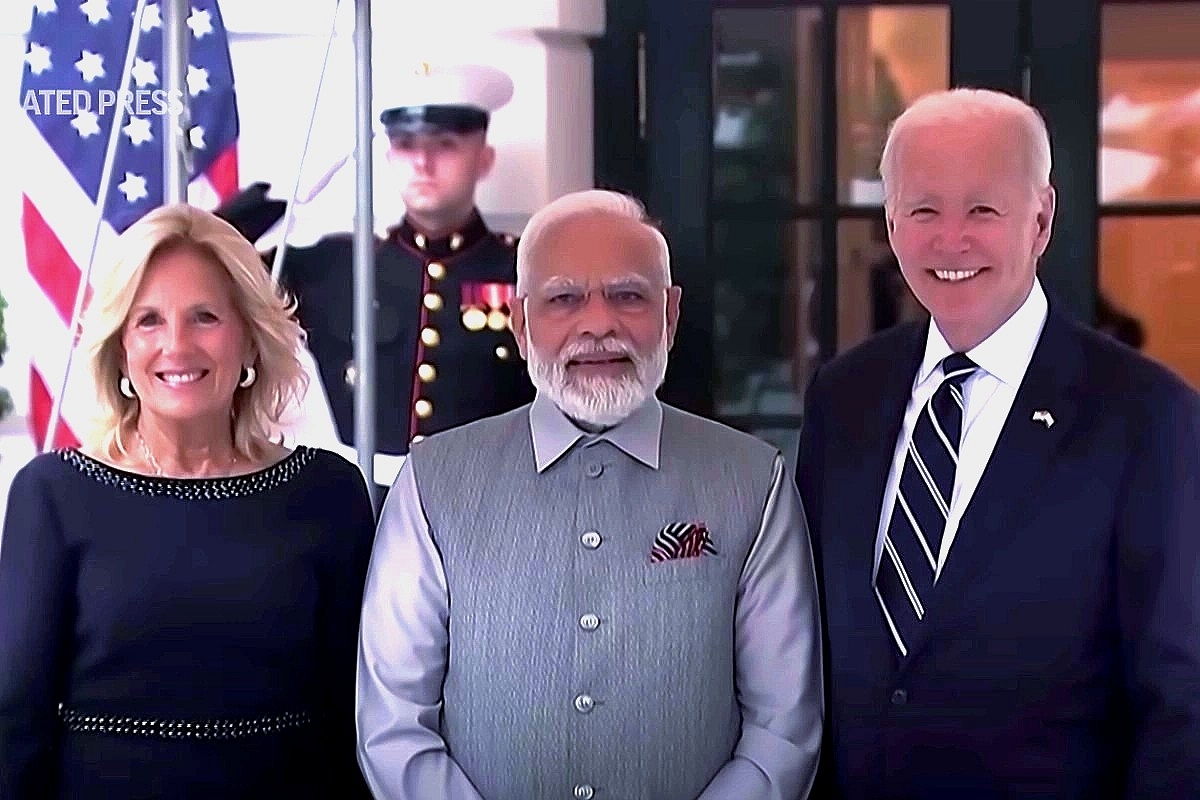News Brief
India And US Explore Out-Of-Court Resolution For Trade Disputes At WTO During PM Modi's Ongoing US Visit: Report

PM Modi with US President Biden and First Lady Jill Biden (Pic Via YouTube Screengrab)
India and the US are reportedly discussing an out-of-court resolution for seven trade disputes at the World Trade Organisation (WTO) during the ongoing state visit of Prime Minister Narendra Modi to the United States.
The discussions are at an advanced stage and a resolution may be reached soon, Moneycontrol reported citing Commerce Ministry sources.
During his three-day state visit to the US that began from Tuesday (21 June), Prime Minister Narendra Modi is expected to discuss various strategic issues, particularly on trade between the two countries.
As the WTO’s appellate body for settlement of disputes remains dysfunctional with the US blocking the appointment of judges, an out-of-court settlement over disputes is the only option right now.
The WTO has said that the US has systemic concerns about the appeals court.
In recent years, the US and India have disagreed on trade, including the US imposing steep steel and aluminum tariffs in 2018.
India's export subsidy programmes, such as the Export-oriented Units Scheme and sector-specific schemes, have also caused tension between the two nations.
The sector-specific schemes include the Electronics Hardware Technology Parks Scheme, the Merchandise Exports from India Scheme, the Export Promotion Capital Goods Scheme, Special Economic Zones, and a duty-free imports for exporters programme.
The US has alleged that these subsidies provide financial benefits to Indian exporters, allowing them to sell goods at lower prices and harming American workers and manufacturers, in violation of WTO norms that prohibit subsidies distorting global trade.
Additionally, the US has initiated a WTO dispute against Indian duties on certain imports of US goods, leading to a difference of opinion on the matter.
Although US-India trade is not dominated by agricultural products, resolving tensions over them has proven to be a long-standing and challenging issue.
According to the information available on WTO website, the US requested consultations with India in 2012 under the dispute settlement system regarding New Delhi's import restrictions on agricultural products from the US.
India, being one of the largest dairy markets globally, has limited US access to it.
Negotiations over US dairy products have been ongoing for years.
India mandates that only dairy products derived from cattle raised on a vegetarian diet for their entire life can enter the country, citing religious and cultural reasons.
In contrast, some US dairy farms feed cattle dietary supplements that are not vegetarian.
India rejected US proposals in 2015 and 2018 for consumer labels indicating the diet of dairy animals.
The US continues to urge New Delhi, including through the India-United States Trade Policy Forum (TPF), to provide greater access to the Indian dairy market.
At the WTO, India's support for its agricultural sector, including the minimum support price (MSP), remains a contentious issue between the two countries.
In June 2019, India retaliated against the US withdrawal of its preferential tariff benefits under the Generalised System of Preferences by implementing tariffs on 28 different products imported from the US.
These tariffs ranged from 1.7 percent to 20 percent and included almonds, apples, walnuts, chickpeas, lentils, phosphoric acid, boric acid, diagnostic regents, binders for foundry moulds, select steel and aluminium items, and threaded nuts.
The tariffs were originally drafted by India in June 2018 as a response to the US decision to impose tariffs on its imports of steel and aluminium articles.
The US Trade Representatives (USTR) released the National Trade Estimate Report 2022, which claims that India is putting up digital trade barriers.
The report states that "India’s proposed regulations on digital trade and electronic commerce include data localization requirements and restrictions on cross-border data flows could serve as a barrier for a wide range of bilateral goods and services trade,”
The Commerce Ministry's provisional data shows that India and the US have achieved a record high in bilateral trade, with the US now being India's largest trading partner.
In 2022-23, the trade between the two countries increased by 7.65 percent to $128.55 billion, compared to $119.5 billion in 2021-22 and $80.51 billion in 2020-21.
The US has been encouraging India to participate in the trade pillar of the US-led Indo-Pacific Economic Framework (IPEF), which is expected to be a topic of discussion during the visit.
India has committed to three pillars of the IPEF, which include building more resilient supply chains, exploring clean energy opportunities, and fighting corruption.
However, India has opted out of the fourth pillar, which is trade, due to concerns about the required commitments on environment, labour, digital trade, and public procurement.
Support Swarajya's 50 Ground Reports Project & Sponsor A Story
Every general election Swarajya does a 50 ground reports project.
Aimed only at serious readers and those who appreciate the nuances of political undercurrents, the project provides a sense of India's electoral landscape. As you know, these reports are produced after considerable investment of travel, time and effort on the ground.
This time too we've kicked off the project in style and have covered over 30 constituencies already. If you're someone who appreciates such work and have enjoyed our coverage please consider sponsoring a ground report for just Rs 2999 to Rs 19,999 - it goes a long way in helping us produce more quality reportage.
You can also back this project by becoming a subscriber for as little as Rs 999 - so do click on this links and choose a plan that suits you and back us.
Click below to contribute.
Latest